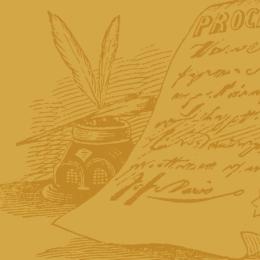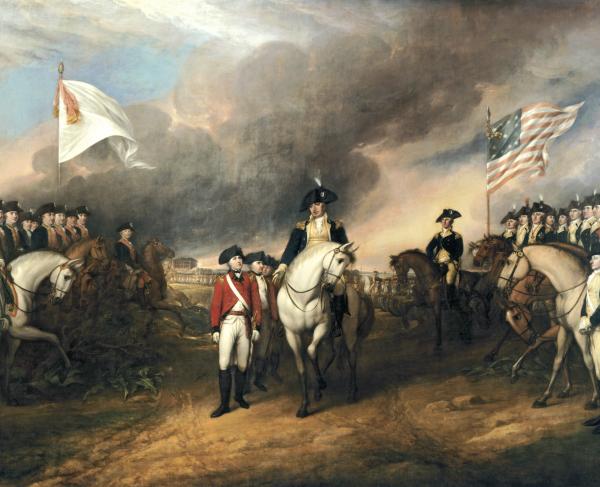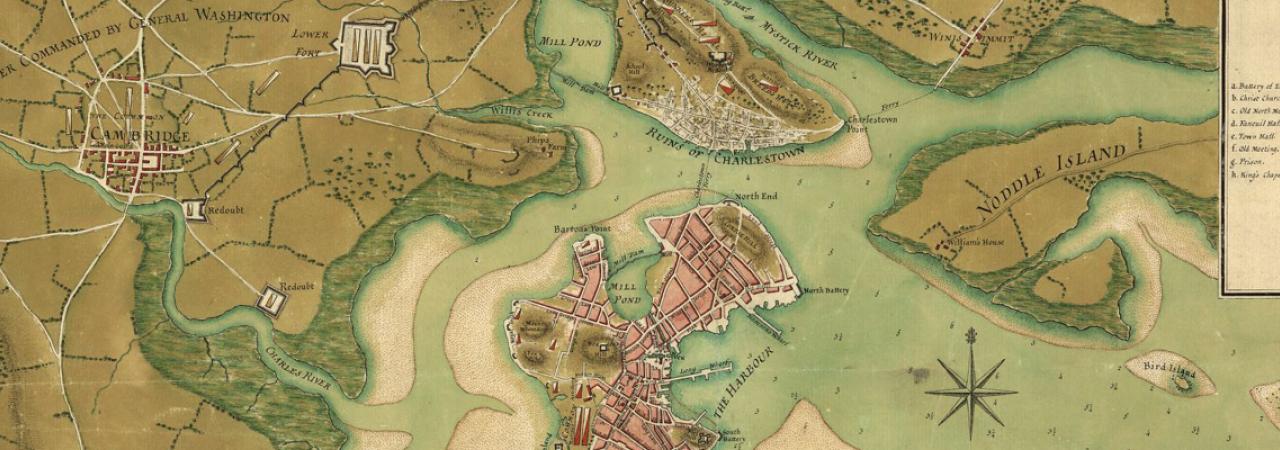
A plan of the town of Boston and its environs, with the lines, batteries, and encampments of the British and American armies.

Long the theater of protest and division against Parliament's taxation, Massachusetts crossed the threshold into a full-scale rebellion against the British Crown in April 1775. While the fuse was long and slow burning, it started in the mid-1760s with the condemnation of the Stamp Act in 1765. Following the Stamp Act crisis, Bostonians' anger only increased. On March 5, 1770, Crown soldiers fired into a mob of civilians in what is today called the Boston Massacre. In December 1773, members of the Sons of Liberty raided a British cargo ship and dumped costly amounts of imported tea into the harbor. It seemed the restless mobs had finally struck a nerve with British authorities: tea. In retaliation, Parliament issued the Coercive Acts, which insulted and hurt the economies of many of the colonies, the Boston Port Act, which closed the harbor, and stripped the colonial assemblies of any power with the Massachusetts Government Act.
British commander Lt. Gen. Thomas Gage, a veteran of the French and Indian War, was appointed military governor of Massachusetts. Capable and initially respected in the colonies, public support for Gage collapsed when he showed no intention of being sympathetic towards the patriots' complaints. However, Gage did not seek to start a war. He granted leniency to protestors and tried several times to work with colonial leaders, actions that earned him criticism from some of his officers and members of Parliament.
In February 1775, Parliament officially stated that Massachusetts was in open rebellion against the Crown. In April, Gage received permission from London to initiate military operations against the colonists and to arrest leaders such as John Hancock and Samuel Adams. Intelligence suggested that munitions were being held in the village of Concord and Gage planned an expedition to seize them. Apprised of the movement on the night of April 18, William Dawes, Samuel Prescott, silversmith Paul Revere and others rode out to warn the countryside.
Lieutenant Colonel Francis Smith led the expedition, made up of the light infantry and grenadier companies from British regiments in Boston. As the British approached Lexington, Smith dispatched Royal Marine Maj. John Pitcairn with a force to take control of the village. As these troops approached the town green Pitcairn encountered a group of militia under Capt. John Parker. It remains a mystery as to who fired first It was just after 5 am on April 19, and a few hundred armed colonists stood before but the ensuing engagement left casualties on both sides. Smith continued to Concord where he skirmished with militia at the North Bridge. The subsequent retreat to Boston turned into a harrowing experience for the British as militia from the surrounding towns swarmed around the column, attacking them at will. By the time Smith reached the safety of Boston he had sustained 273 casualties and Gage found himself bottled up inside the city. The Massachusetts Provincial Congress quickly moved to organize the various militias into an army with Artemas Ward in command.
The Continental Congress, meeting in Philadelphia, now had to deal with the reality that Massachusetts was at war with Great Britain. On June 14, the Congress decided to absorb the forces in Massachusetts into the Continental Army. Massachusetts delegate John Adams nominated the Virginia Colonel George Washington to lead the new American forces gathering in Boston. Adams, ever the politician, recognized the importance of a Virginian leading the continental forces. Washington, the only member of Congress who wore the military uniform, accepted the nomination, even if he felt himself unqualified for the immensity of the position.
As Washington prepared to leave for Boston, events continued to worsen any chance of reconciliation. The Americans had surrounded Boston on the mainland, and Gage’s forces knew they had to mount an attack or face the possibility of an assault. Gage had been joined in late May by British Maj. Gens. John Burgoyne, Henry Clinton, and William Howe, along with about four thousand reinforcements. Together, they planned to break the siege. North of the Boston peninsula lay the small town of Charlestown, which sat on a peninsula that jutted into the harbor. South of Boston lay Dorchester Heights, a ridge with a commanding view and tactical advantage for whoever held it over the entire harbor. And to the southwest lay the hamlet of Roxbury, at the foot of the land bridge with Boston. Gage planned to send a detachment to establish a presence atop Dorchester Heights, and then assemble the remaining force to march on Roxbury and push the rebels west away from Boston. Unfortunately for the British commanders, the Americans acted first. Under the command of Colonel William Prescott, about twelve hundred militia crossed the Charlestown Meck onto the peninsula on June 16. Under the cover of night, Prescott built a redoubt on Breed’s Hill, the below Bunker Hill, which gave a clear view of Boston to the south.

The following morning, the British command held their war council. Gage and his subordinates settled on a plan for Howe to land a force at Moulton's Point and then move along the beach of the Mystic River to flank the redoubt and cut Prescott off from the main land. The attack commenced shortly after 3 pm on June 17. Howe divided his command into several columns, and three assaults occurred. The Americans held their ground marvelously for the first two, sending the British regulars running back to their assembly areas. Those that did not retreat lay on the ground in bloody tangles from musket fire. The third assault concentrated the most men yet on the American redoubt on Breed’s Hill. By this point, the militia had run out of ammunition. Soon, the British bayonet appeared over the wall, and the Americans pulled back. A well-organized retreat materialized in the rear, and most made it back to the safety of the mainland. When the smoke began to settle, the Americans had lost over four hundred men, the British over one thousand. The aftermath of the Battle of Bunker Hill shattered British confidence in Gage and he was later replaced by Howe.
Washington arrived in Cambridge on July 2, and immediately set about to organize his army. The bands of encamped militia were entirely ignorant of military tactics, formations, and discipline. Washington established order, gathered provisions, and trained the men. Among his subordinates were Major Generals Horatio Gates and Charles Lee, both British-born transplants who served alongside Washington in the French and Indian War; Major General Thomas Mifflin, Brigadier General Nathanael Greene, and Colonel Henry Knox, a former bookstore from Boston. None had worked together on a mission whose scale was assembling and drilling an entire army from scratch. To complicate matters, Washington had to strategize how to dislodge the British from Boston, how to remain answerable to the wishes of Congress, and how to battle elements within and outside of his control. Provisions were scarce, gunpowder scarcer; there were no artillery pieces, and smallpox was hitting the crowds of men at an ever-increasing rate.
Over the next several months, skirmishes broke out between small detachments of British and Continental troops. Most saw only a handful of volleys exchanged before a ceasefire would commence. Other times, daring raids upended peaceful spells and reminded the armies that a war was indeed being waged. Washington committed one thousand troops to invade Canada at the request of Congress with the hopes of routing the British garrisons at Montreal and Quebec, and bringing the vast territory into the American fold. It nearly succeeded except for an untimely defeat by exhausted American forces under Richard Montgomery and Benedict Arnold at Quebec.
By winter, the British under Howe were stuck in Boston, awaiting reinforcements, and the Continental Army under Washington remained lurking on the mainland in continuous surveillance of the harbor. Washington contended with the daily struggles of the new army, including enlistments. One of the most glaring was that of enlistments.
Howe also faced problems such as feeding his men and disease. Firewood was scarce, leading British troops to cut down every tree in town and dismantle several buildings. The British command knew they had to make a move or face the impossible: defeat.
In late January, 1776, Col. Henry Knox arrived from Fort Ticonderoga with badly needed artillery for the Continental Army. Washington now saw his objective: he would establish a foothold for his artillery atop Dorchester Heights and bombard the British in Boston and the harbor below. By early March, much of the artillery had been moved to Dorchester Heights. The frozen ground made digging near impossible, so the army employed carpenters to use timber to build breastworks. Out of sight of the British, on the morning of March 6, William Howe is said to have seen the new fortifications and exclaimed, “My God, these fellows have done more work in one night than I could make my army do in three months.”
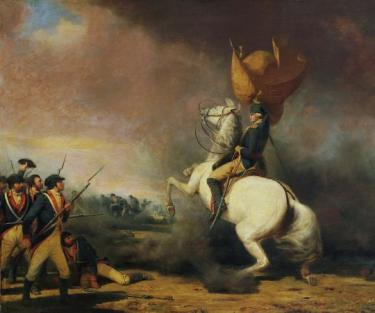
The British tried to dislodge the American artillery, but their cannon and field pieces could not elevate to reach the fortifications. In response, Washington, now ascending the slopes of Dorchester Heights, could be heard yelling, “Remember it is the fifth of March! Avenge the death of your brethren!” (referencing the Boston Massacre). On the opposite side of the harbor in the Charles River, nearly four thousand Continentals under the commands of Generals Greene, Israel Putnam, and John Sullivan prepared their forces to row across the harbor and land on the northern side of the Boston peninsula. Washington’s amphibious plan had finally won its day in his war council. For his part, Howe was planning to attack Dorchester Heights, a decision that many in his army questioned. Fearful of a repeat of Bunker Hill, and constantly careening their necks to gaze upward at the slopes of Dorchester, morale in the British camp was not high for the move. Howe’s decision to attack seemed to halt during his war council on the evening of March 6. The vote was to evacuate Boston and not engage the Americans. Overnight, a torrential storm blew in, possibly a hurricane, that upended any further chances of an impending battle. On March 8, Howe sent a letter to the American lines, asking Washington for a truce: Howe would not burn Boston to the ground if the Americans allowed him and the British to sail unmolested out of the harbor. The wish was granted, and nearly eleven thousand people boarded the British ships and transports, where they departed on March 17. Hundreds of loyalists were taken to Nova Scotia and New Brunswick, Canada, where they settled and rebuilt their lives.
The loss of Boston was a temporary setback. In reality, holding the town of Boston proved to be a weak seat to command a war. His eyes settled further south toward another formidable harbor and port: New York. From a logistical standpoint, New York would serve the British far better than Boston. It was more centered in the colonies, had ample access to the Atlantic Ocean, and the Hudson River cut north toward Lake Champlain, which connected to British-held Canada. The British thought they would be far more likely to gain an advantage if they could successfully establish a footing in New York.
Had the Americans blundered and been defeated at Boston, either by a forced error on Washington’s part, or an aggressive advance by Howe, in all likelihood, the rebellion would have collapsed, and American independence would have evaporated before it could gain serious momentum.
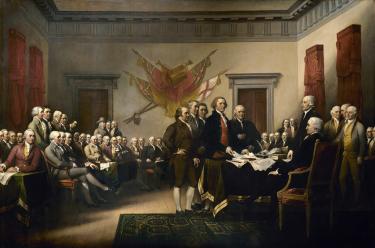
As the summer of 1776 unfolded, the winds of change were blowing in Philadelphia where delegates of the Continental Congress pushed ever closer to complete independence from Great Britain. In no small part was this a testament to the oratory skill and power of Massachusetts’ John Adams. With momentum going in their direction and luck seemingly on their side, the New Englander made his case on July 1. Outside the statehouse in Philadelphia, a thunderstorm ravaged when he spoke, attempting to wrestle the message from the ears of the men in session. As the opening of the great conflict had given hope to a North American world without British control, every member seated knew that with his vote, they would each lead the emerging country into the unknown.
Further Reading
- The Organization of the British Army in the American Revolution: By Edward E. Curtis
- Redcoats and Rebels: The American Revolution Through British Eyes: By Christopher Hibbert
- The Boston Tea Party: By Benjamin Woods Labaree
- 1776: By David McCullough
- Bunker Hill: A City, A Siege, A Revolution: By Nathaniel Philbrick
Related Battles
19
79
450
1,054
93
300
